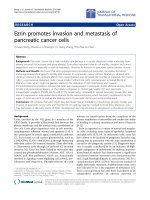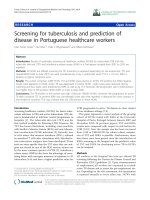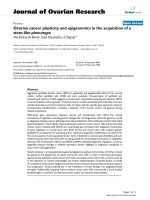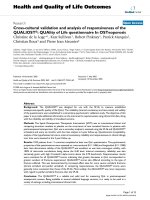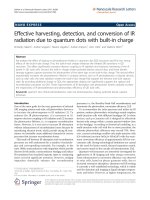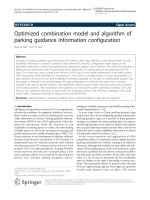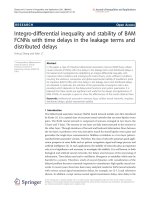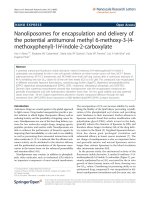Báo cáo hóa học: " Nanoliposomes for encapsulation and delivery of the potential antitumoral methyl 6-methoxy-3-(4methoxyphenyl)-1H-indole-2-carboxylate" doc
Bạn đang xem bản rút gọn của tài liệu. Xem và tải ngay bản đầy đủ của tài liệu tại đây (336.28 KB, 6 trang )
NANO EXPRESS Open Access
Nanoliposomes for encapsulation and delivery of
the potential antitumoral methyl 6-methoxy-3-(4-
methoxyphenyl)-1H-indole-2-carboxylate
Ana S Abreu
1,2*
, Elisabete MS Castanheira
1
, Maria-João RP Queiroz
2
, Paula MT Ferreira
2
, Luís A Vale-Silva
3
and
Eugénia Pinto
3
Abstract
A potential antitumoral fluorescent indole derivative, methyl 6-methoxy-3-(4-methoxyphenyl)-1H-indole-2-
carboxylate, was evaluated for the in vitro cell growth inhibition on three human tumor cell lines, MCF -7 (breast
adenocarcinoma), A375-C5 (melanoma), and NCI-H460 (non-small cell lung cancer), after a continuous exposure of
48 h, exhibiting very low GI
50
values for all the cell lines tested (0.25 to 0.33 μM). This compound was encapsulated
in different nanosized liposome formulations, containing egg lecithin (Egg-PC), dipalmitoyl phosphatidylcholine
(DPPC), dipalmitoyl phosphatidylglycerol (DPPG), DSPC, cholesterol, dihexadecyl phosphate, and DSPE-PEG.
Dynamic light scattering measurements showed that nanoliposomes with the encapsulated compound are
generally monodisperse and with hydrodynamic diameters lower than 120 nm, good stability and zeta potential
values lower than -18 mV. Dialysis experiments allowed to monitor compound diffusion through the lipid
membrane, from DPPC/DPPG donor lipo somes to NBD-labelled lipid/DPPC/DPPG acceptor liposomes.
Introduction
Anticancer drugs are crucial agents in the global approach
to fight cancer. Drug-loaded nanoparticles provide a per-
fect sol ution to afford higher thera peutic efficacy and/or
reducing toxicity and the possibility of targeting cancer tis-
sues. Nanoliposomes are one of the best drug delivery sys-
tems for low molecular weight drugs, imaging agents,
peptides, proteins, and nucleic acids. Nanoliposomes are
able to enhance the performance of bioactive agents by
improving their bioavailability, in vitro and in vivo stability,
as well as preventing thei r unwanted interaction s with
other molecules [1-3]. It is believed that the efficient anti-
tumor activity can be attributed to the selective delivery
and the preferential accumulation of the liposome nano-
carrier in the tumor tissue via the enhance d permeability
and retention effect [4-6].
Nanoliposomes may contain, in addition to phospholi-
pids, other molecules such as cholesterol (Ch) which is
an important component of most natural membranes.
The incorporation of Ch can increase stability by modu-
lating the fluidity of the lipid bilayer preventing crystalli-
zation of the phospholipid acyl chains and providing
steric hindrance to their movement. Further advances in
liposome research found that surface modification with
polyethylene glycol ( PEG), which is inert in the body,
generally reduces the clear ance of liposome by RES, and
therefore allows longer circulatory life of the drug deliv-
ery system in the blood [3]. Pegylated liposomal doxoru-
bicin has shown great prolonged circulation and
substantial efficacy in breast cancer treatment [7]. The
net charge of nanoliposomes is also an i mportant factor
and generally anionic an d neutral liposomes survive
longer than cationic liposomes in the blood circulation
after intravenous injection [8,9].
In the present study, the antitumoral activity of the
fluorescent indole derivative 1, methyl 6-methoxy-3-(4-
methoxyphenyl)-1H-indole-2-carboxylate (Figure 1), pre-
viously synthesized by us [10], w as tested for the in vitro
growth of three human tumor cell lines, showing very
low GI
50
values. Considering its promising utility as an
antitumoral drug, compound 1 was encapsulated in dif-
ferent nanoliposome formulations and the mean size, size
* Correspondence:
1
Centre of Physics (CFUM), University of Minho, Campus de Gualtar, 4710-
057 Braga, Portugal
Full list of author information is available at the end of the article
Abreu et al. Nanoscale Research Letters 2011, 6:482
/>© 2011 Abreu et al; licensee Springer. This is an Open Access a rticle distri buted und er the terms of the Cre ative Common s Attrib ution
License ( which permits unrestricted use , distribution, and reproduction in any medium,
provide d the original work is properly cited.
distribution, zeta potential, and stability were evaluated,
keeping in mind future drug delivery applications using
this compound as an anticancer drug.
The intrinsic fluorescence of compo und 1 was used to
obtain relevant information about its location in nanolipo-
somes and its diffusion across the membrane in dialysis
experiments. For the latter, Förster resonance energy
transfer (FRET) between compound 1 (energy donor) and
nitrobenzoxadiazole (NBD)-labelled lipids in different
positions (at head group or fatty acid), acting as energy
acceptor, was used to monitor compound behavior, as this
photophysical process strongly depends on the donor-
acceptor distance [11]. These studies are important, not
only to evaluate the best liposome formulations to encap-
sulate this promising antitumoral agent, but also to con-
firm the possibility of compound 1 to permeate the lipid
bilayer (cell membrane model).
Experimental
Nanoliposome preparation
Dipalmitoyl phosphatidylcholine (DPPC), egg yolk phos-
phatidylcholine (Egg-PC), dipalmitoyl phosphatidylglycerol
(DPPG), Ch, and dihexadecyl phosphate (DCP) were
obtained from Sigma-Aldrich (St. Louis, MI, USA). Dis-
tearoyl phosphatidylch oline (D SPC) and distearoyl phos-
phatidylethanolamine-N-[methoxy(poly ethylene glycol)-
2000] (ammonium salt) (DSPE-PEG) were purchased from
Avanti Polar Lipids (Alabaster, AL, USA). Fluorescent-
labelled lipids N-(7-nitrobenz-2-oxa-1, 3-diazol -4-yl)-1,2-
dihexadecanoyl-sn-glycero-3-phosphoethanolamine
(triethylammonium salt) (NBD-PE), 2-(6-(7- nitrobenz-2-
oxa-1,3-diazol-4-yl) amino)hexa noyl-1- hexadecan oyl- sn-
glycero-3-phosphocholine (NBD-C
6
-HPC), and 2-(12-(7-
nitrobenz-2-oxa-1,3-diazol-4-yl)amino)dodecanoyl-1-
hexadecanoyl-sn-glycero-3-phosphocholine (NBD-C
12
-
HPC) were obtained from Invitrogen (Carlsbad, CA, USA).
Nanoliposomes were prepared by injection of an etha-
nolic solution of lipids/compound 1 mixture in an aqu-
eous buffer solution under vigorous stirring, above the
lipid melting transition temperature (ca.41°CforDPPC
[12] and 39.6°C for DPPG [13]), followed by three extru-
sion cycles through 100 nm polycarbonate membranes.
The final lipid concentration was 1 mM, with a com-
pound/lipid molar ratio of 1:333.
Encapsulation efficiency (percent)
The encapsulation efficiency (EE) was determined
through fluorescence emission measurements. After pre-
paration, liposomes were subjected to centrifugation in
an Eppendorf 5804 R centrifuge (Hamburg, Germany) at
11,000 rpm for 60 min. The supernatant was pipetted
out, and its fluorescence was measured, allowi ng to cal-
culate the compound concentration using a calibration
curve previously obtained. The encapsulation eff iciency
of compou nd 1 was determined using the following
equation:
EE
(
%
)
= (Amount o
f
total compound 1 in the l iposome preparation −
Amount of non-encapsulated compound
)
/
(
Amount of total compound 1 in the l iposome preparation
)
× 100
.
DLS and zeta potential measurements
The liposomes’ mean diameter, size distribution (poly-
dispersity index), and zeta potential were measured with
dynamic light scattering (DLS) NANO ZS Malvern
Zetasizer equipment (Worcestershire, UK), at 25°C,
using a He-Ne laser of 633 nm and a detector angle of
173°. Five independent measurements were performed
for each sample. Malvern dispersion technology software
(DTS) (Worcestershire, UK) was used with multiple nar-
row mode (high-resolu tion) data processing, and mean
size (nanometer), and error values were considered.
Dialysis
Permeability studies of compound 1 between DPPC/
DPPG mixed liposomes (donor liposomes) and NBD-
labelled DPPC/DPPG liposomes (acceptor liposomes)
were performed using two different sizes of dialysis
membranes (6 to 8 KDa and 12 to 14 KDa). Three
fluorescent NBD-labelled lipids were used, either
labelled at head group (NBD-PE) or labelled at fatty acid
(NBD-C
6
-HPC and NBD-C
12
-HPC). The experiments
were carried out using a reusable 96-well micro-equili-
brium dialysis device HTC 96 (Gales Ferry, CT, USA)
and left in an incubator at 25°C (80 rpm) for 36 h.
Spectroscopic measurements
Fluorescence measurements were obtained in a Fluoro-
log 3 spectrofluorimeter (HORIBA Scientific, Kyoto,
Figure 1 Structure of methyl 6-methoxy- 3-(4-methoxyphenyl)-
1H-indole-2-carboxylate.
Abreu et al. Nanoscale Research Letters 2011, 6:482
/>Page 2 of 6
Japan), equipped with double monochromators in both
excitation and emission and a temperature controlled
cuvette holder. Fluorescence spectra were corrected for
the instrumental response of the system. Nanoliposomes
containing only the fluorescent compound 1 (energy
donor) served as negative (no FRET) control. The per-
centage of energy transfer, ET (percent), was calculated
from the fluorescence emission intensities,
ET
(
%
)
=
1 −
I
DA
I
D
i
− I
D
f
× 100
,
where I
DA
is the donor emission intensity after the
dialysis experiment in NBD-labelled lipid/DPPC/DPPG
liposomes,
I
D
i
is the initial donor emission intensity in
DPPC/DPPG liposomes and
I
D
f
is the final donor emis-
sion intensity in DPPC/DPPG liposomes.
Biological activity
Fetal bovine serum, L-glutamine, phosphate-buffered
saline, trypsin, and RPMI-1640 medium were purchased
from Invitrogen (Carlsbad, CA, USA). Acetic acid,
dimethyl sulfoxide (DMSO), doxorubicin, penicillin,
streptomycin, ethylenediaminetetraacetic acid, sulforho-
damine B, and trypan blue were from Sigma-Aldrich (St.
Louis, MI, USA). A stock solution of 1 was prepared in
DMSO and was kept at -70°C. Appropriate dilutions of
the compound were freshly prepared in the test medium
just prior to the assays. The vehicle solvent had no
influence on the growth of the cell lines. Human tumor
cell lines MCF-7 (breast adenocarcinoma), NCI-H460
(non-small cell lung cancer), and A375-C5 (melanoma)
were tested. MCF-7 and A375-C5 were obtained from
the European Collection of Cell Cultures (Salisbury,
UK), and NCI-H460 was kindly provided by National
Cancer Institute (NCI) (Bethesda, MD, USA). The pro-
cedure followed was described elsewhere [14]. The in
vitro effect on the growth of human tumor cell lines
was evaluated according t o the procedure adopted by
the NCI in their “ In vitro Anticancer Drug Discovery
Screen,” using the protein-binding dye sulforhodamine
B to assess cell growth [15,16]. Doxorubicin was tested
following the same protocol and was used as positive
control.
Results and discussion
Antitumoral evaluation
The in vitro growth inhibitory activity of compound 1
was evaluated using three human tumor cell lines, breast
adenocarcinoma (MCF-7), non-small cell lun g cancer
(NCI-H460), and a me lanoma cell line (A375-C5), after
48 h of continuous exposure to compound 1.Results
given in concentrations that were able to cause 50% of
cell growth inhibitio n (GI
50
) are summariz ed in Table 1.
It can be observed that compound 1 inhibited the growth
of the three tumor c ell lines with very low GI
50
values.
These inhibitory concentrations are significantly lower
than those obtained with other potential antitumoral
compounds recently tested [17-19], some of them also
containing the indole nucleus [17-21], and point to a pro-
mising utility of this compound as an antitumoral agent.
Doxorubicin, used as positive control, presents a very
high cytotoxicity because the planar aromatic moiety effi-
ciently intercalates into DNA base pairs, while the six-
membered daunosamine sugar binds to the minor
groove, interacting with flanking base pairs adjacent to
the intercalation site [22]. Neverthel ess, doxorubicin pre-
sents also a high toxicity for the human body, and the
search for other antitumoral compounds, even less active
but also less toxic, is still an active domain of interest.
Nanoliposomes characterization
Selected liposome formulations [23-25] with encapsulated
compound 1 were prepared. All the formulations have
mean hydrodynamic diameters lower than 120 nm, gener-
ally low polydispersity and very good encapsulation effi-
ciency (Table 2). Pegylation of nanoliposomes surface with
DSPE-PEG generally leads to the increase of the hydrody-
namic diameter that, however, remains close to 100 nm.
The mean diameter of the Egg-PC/DCP/Ch (7:2:1) lipo-
some is considerably smaller than the others (Table 2), but
with a higher polydispersity index. Formulations including
egg phosphatidylcholine show a tendency to a lower parti-
cle size. All the different nanoliposomes prepared are gen-
erally monodisperse and stable after 2 weeks, with no
evidence of aggregation (Table 2).
Zeta potential measurements were used to evaluate the
relationship between surface charge and stability. All the
nanoliposome formulations have negative z eta potential
(Table 2). The higher colloidal stability was obtained for
Egg-PC/Ch/DPPG (6.25:3:0.75) formulation (ζ value
more negative), while the lower stabili ty (higher aggrega-
tion tendency) is observed for Egg-PC/Ch/DSPE-PEG
(5:5:1) liposomes, which exhibit a ζ-potential value clearly
less negative than -30 mV.
Dialysis
Previous fluorescence experiments showed the possibi-
lity of FRET between the excited compound 1 and the
Table 1 Values of compound 1 concentration needed for
50% of cell growth inhibition (GI
50
)
GI
50
(μM)
MCF-7 NCI-H460 A375-C5
1 0.37 ± 0.02 0.33 ± 0.03 0.25 ± 0.02
Results represent means ± SEM of three independent experiments performed
in duplicate. Doxorubicin was used as positive control (GI
50
: MCF-7 = 43.3 ±
2.6 nM; NCI-H460 = 35.6 ± 1.6 nM; and A375-C5 = 130.2 ± 10.1 nM).
Abreu et al. Nanoscale Research Letters 2011, 6:482
/>Page 3 of 6
widely used fluoresc ence probe nitrobenzo xadiazole,
NBD.TheFRETmechanisminvolvesadonorfluoro-
phore in an excited electronic state (here compound 1),
which may transfer its excitation energy to a nearby
acceptor chromophore (NBD) in a nonradiative way
through long-range dipole-dipole interactions. Because
the range over which the energy transfer can occur is
limited to approximately 100 Å and the efficiency of
transfer is extremely sensitive to the donor-acceptor
separation distance, resonance energy transfer measure-
ments can be a valuable t ool for probing molecular
interactions [11].
Taking advantage of the possibility of FRET from the
excited compound 1 (donor) to the nitrobenzoxadiazole
moiety, the diffusion of compound 1 in dialysis e xperi-
ments was monitored using this photophysical process.
Two different dialysis membranes (6 to 8 KDa or 12 to 14
KDa) were tested. The experiments were carried out at 25°
C for 36 h and are schematically illustrated in Figure 2.
DPPC/DPPG (1:1) liposomes with encapsulated com-
pound 1 (donor liposomes) were placed at one side of the
dialysis membrane (Figure 2, left), while NBD-labelled
lipid/DPPC/DPPG liposomes without compound (accep-
tor liposomes) are placed at the other side (Figure 2,
right). After the experiment (36 h), the occurrence of
energy transfer (FRET) from c ompound 1 to NBD,
detected in the solution located at the right side, is a proof
of compound diffusion from the donor liposomes, passing
across the dialysis membrane and incorporation in the
membrane of the acceptor liposomes. The phospholipids
DPPC and DPPG are the main components of biological
membranes and are both in the gel phase at room tem-
perature. This fact is expected to restrain the diffusion of
compound 1 and, therefore, if the compound diffuses
Table 2 Hydrodynamic diameter, polydispersity, zeta potential, and encapsulation efficiency of several drug-loaded
liposomes
Drug-loaded liposomes Hydrodynamic diameter (nm)
(mean ± SD)
Polydispersity (mean ±
SD)
Zeta potential (mV) (mean
± SD)
Encapsulation
efficiency
DPPC/Ch/DSPE-PEG (5:5:1) 115.4 ± 0.5 0.15 ± 0.01 -30 ± 1 97%
1 week after 116 ± 2 0.15 ± 0.01
2 weeks after 116.0 ± 0.8 0.15 ± 0.01
DSPC/Ch/DSPE-PEG (5:5:1) 120 ± 2 0.19 ± 0.01 -27 ± 4 96%
Egg-PC/Ch/DSPE-PEG
(5:5:1)
104.3 ± 0.6 0.25 ± 0.01 -19 ± 2 99%
Egg-PC/DCP/Ch (7:2:1) 79.3 ± 0.8 0.37 ± 0.01 -39 ± 3 98%
Egg-PC/Ch/DPPG
(6.25:3:0.75)
103.5 ± 0.9 0.12 ± 0.01 -52 ± 6 98%
2 weeks after 95.4 ± 0.5 0.14 ± 0.01
Egg-PC/DPPG/DSPE-PEG
(5:5:1)
104 ± 3 0.27 ± 0.01 -43 ± 3 99%
Standard deviations were calculated from the mean of the data of a series of five experiments conducted using the same parameters.
Figure 2 Schematic dialysis experiment from DPPC/DPPG liposomes to NBD-labelled lipid/DPPC/DPPG liposomes.
Abreu et al. Nanoscale Research Letters 2011, 6:482
/>Page 4 of 6
through the dialysis membrane in this situation, this will
be even easier with the lipids that are in the fluid phase.
The NBD-labelled lipids w ere either labelled at head
group (NBD-PE), at position 6 of the fatty acid chain
(NBD-C
6
-HPC) or at position 12 of the fatty acid chain
(NBD-C
12
-HPC). Figure 3 displays (as exa mples) the
emission spectr a of compound 1 in DPPC/DPPG donor
liposomes and of the NBD-PE/DPPC/DPPG acceptor
nanoliposomes, before (t = 0 s) and after (t =36h)dif-
fusion of compound 1 through the two dialysis mem-
branes used in the study. After the dialysis assay, the
fluorescence of compound 1 in the donor liposomes is
notably reduced (Figure 3), and its e mission can be
detected in the acceptor liposomes solution, showing
the diffusion of compound 1 through the dialysis mem-
brane. Besides, due to the energy transfer from com-
pound 1 t o NBD, the fluorescence intensity of the latter
notably increases (Figure 3). The effect is stronger for
the membrane of 12 to 14 KDa.
The percentage of energy transfer from compound 1
to NBD is higher when the acceptor nanolipo somes are
labelled with NBD-PE (NBD linked at lipid head group)
(Figure 4). In this case, it can be observed that energy
transfer is higher fo r the 12- t o 14-KDa dialysis mem-
brane. It can also be concluded that, after 36 h of dialy-
sis, compound 1 is located mainly near the polar head
groups of the phospholipids in the acceptor nanolipo-
somes, as energy transfer to NBD is less efficient when
this energy acceptor is located deeper in the lipid chain
(NBD-C
12
or NBD-C
6
) (Figure 4).
Conclusions
The fluorescent methyl 6-methoxy-3-(4-methoxyphenyl)-
1H-indole-2-carboxylate (1) exhibits excellent antitu-
moral properties, with very low GI
50
values in the three
human tumor cell lines tested. Several nanoliposome for-
mulations containing the fluorescent drug were success-
fully prepar ed by an injection/extrusion combined
method, with particle sizes lower than 120 nm, low poly-
dispersity index, and good stability after 2 weeks. The
Egg-PC/Ch/DPP G (6.2 5:3:0.75) and Egg-PC/DPPG/
DSPE-PEG (5:5:1) showed to be the best formulations for
encapsulation of this compound, considering their low
hydrodynamic diameter, high negative zeta potential, and
very high encapsulation efficiency. Dialysis experiments
allowed to follow compound diffusion from DPPC/DPPG
donor liposomes to NBD-labelled lipid/DPPC/DPPG
acceptor liposomes, through dialysis membranes of 6 to 8
KDaand12to14KDa.Theseresultsmaybeimportant
for future drug delivery applications using nanoliposomes
for the encapsula tion and transport of this promising
antitumoral compound. Further developments of the pre-
sent study will involve assays of liposome cell internaliza-
tion and mechanism of action, keeping in mind the
application of this compound as an antitumoral drug.
Abbreviations
A375-C5: melanoma cell line; Ch: cholesterol; DCP: dihexadecyl phosphate ;
DLS: dynamic light scattering; DPPC: dipalmitoyl phosphatidylcholine; DPPG:
dipalmitoyl phosphatidylglycerol; DSPC: distearoyl phosphatidylcholine; DSPE:
PEG: 1,2-distearoyl-sn-glycero-3-phosphoethanolamine-N-[methoxy
(polyethylene glycol)-2000]; DTS: dispersion technology software; Egg-PC: egg
yolk phosphatidylcholine; FRET: Förster resonance energy transfer; MCF-7:
breast adenocarcinoma cell line; NBD-C
6
-HPC: 2-(6-(7-nitrobenz-2-oxa-1,3-
diazol-4-yl)amino)hexanoyl-1-hexade canoyl- sn-glycero-3-phosphocholine;
NBD-C
12
-HPC: 2-(12-(7-nitrobenz-2-oxa-1,3-diazol-4-yl)amino)dodecanoyl-1-
hexadecanoyl-sn-glycero-3-phosphocholine; NBD-PE: N-(7-nitrobenz-2-oxa-1,3-
diazol-4-yl)-1,2-dihexadecanoyl-sn-glycero-3-phosphoethanolamine; NCI-H460:
non-small cell lung cancer line.
Acknowledgements
Thanks are due to the Foundation for Science and Technology (FCT,
Portugal) for financial support through the research centers (CFUM and CQ-
UM) and project PTDC/QUI/81238/2006 (cofinanced by FEDER/COMPETE, ref.
FCOMP-01-0124-FEDER-007467). A.S. Abreu (SFRH/BPD/24548/2005) and
Figure 3 Fluoresc ence spectra of compound 1 in DPPC/DPPG
liposomes and NBD-PE labelled DPPC/DPPG liposomes before
and after dialysis.
Figure 4 Percentage of drug transfer in dialysis between
DPPC/DPPG liposomes and NBD-labelled lipid/DPPC/DPPG
liposomes.
Abreu et al. Nanoscale Research Letters 2011, 6:482
/>Page 5 of 6
L. Vale-Silva (SFRH/BPD/29112/2006) acknowledge FCT for their postdoctoral
grants.
Author details
1
Centre of Physics (CFUM), University of Minho, Campus de Gualtar, 4710-
057 Braga, Portugal
2
Centre of Chemistry (CQ/UM), University of Minho,
Campus de Gualtar, 4710-057 Braga, Portugal
3
Laboratory of Microbiology,
Faculty of Pharmacy and Centre of Medicinal Chemistry (CEQUIMED),
University of Porto, Rua Aníbal Cunha 164, 4050-047 Porto, Portugal
Authors’ contributions
ASA and EMSC conceived the study, were responsible for the interpretation
of results, and drafted the manuscript. ASA carried out the liposome
preparation, the DLS and zeta potential measurements and dialysis
experiments in liposomes. M-JRPQ and PMF supervised the organic synthesis
and compound characterization and participated in the draft of the
manuscript. LAVS was responsible for the antitumoral evaluation of the
compound. EP supervised the studies of biological activity. All authors read
and approved the final manuscript.
Competing interests
The authors declare that they have no competing interests.
Received: 28 October 2010 Accepted: 3 August 2011
Published: 3 August 2011
References
1. Huynh NT, Passirani C, Saulnier P, Benoit JP: Lipid nanocapsules: a new
platform for nanomedicine. Int J Pharm 2009, 379:201.
2. Mozafari MR, Mortazavi SM: Nanoliposomes: From Fundamental to Recent
Developments. Victoria: Trafford; 2005.
3. Andresen TL, Jensen SS, Jorgensen K: Advanced strategies in liposomal
cancer therapy: problems and prospects of active and tumor specific
drug release. Prog Lipid Res 2005, 44:68.
4. Matsumura Y, Maeda H: A new concept for macromolecular therapeutics
in cancer-chemotherapy - mechanism of tumoritropic accumulation of
proteins and the antitumor agents smancs. Cancer Res 1986, 46:6387.
5. Maeda H, Bharate GY, Daruwalla J: Polymeric drugs for efficient tumor-
targeted drug delivery based on EPR-effect. Eur J Pharm Biopharm 2009,
71:409.
6. Li S-D, Huan L: Nanoparticles evading the reticuloendothelial system:
Role of the supported bilayer. Biochimica et Biophysica Acta 2009,
1788:2259.
7. Park JW: Liposome-based drug delivery in breast cancer treatment. Breast
Cancer Res 2002, 4:93.
8. Wang XY, Ishida T, Ichihara M, Kiwada H: Influence of the physicochemical
properties of liposomes on the accelerated blood clearance
phenomenon in rats. J Control Release 2005, 104:91.
9. Woodle MC, Lasic DD: Sterically stabilized liposomes. Biochim Biophys Acta
1992, 1113:171.
10. Queiroz M-JRP, Abreu AS, Castanheira EMS, Ferreira PMT: Synthesis of new
3-arylindole-2-carboxylates using beta, beta-diaryldehydroamino acids as
building blocks. Fluorescence studies. Tetrahedron 2007, 63:2215.
11. Valeur B: Molecular Fluorescence - Principles and Applications. Weinheim:
Wiley-VCH; 2002.
12. Lentz BR: Membrane fluidity as detected by diphenylhexatriene probes.
Chem Phys Lipids 1989, 50:171.
13. Vincent JS, Revak SD, Cochrane CD, Levin IW: Interactions of model
human pulmonary surfactants with a mixed phospholipid-bilayer
assembly. Raman spectroscopic studies. Biochemistry 1993, 32:8228.
14. Queiroz M-JRP, Calhelha RC, Vale-Silva LA, Pinto E, Lima RT,
Vasconcelos MH: Efficient synthesis of 6-(hetero)arylthieno[3,2- b]pyridines
by Suzuki-Miyaura coupling. Evaluation of growth inhibition on human
tumor cell lines, SARs and effects on the cell cycle. Eur J Med Chem 2010,
45:5628.
15. Skehan P, Storeng R, Scudiero D, Monks A, McMahon J, Vistica D, Warren JT,
Bokesch H, Kenny S, Boyd MR: New colorimetric cytotoxicity assay for
anticancer-drug screening. J Natl Cancer Inst 1990, 82
:1107.
16. Monks A, Scudiero D, Skehan P, Shoemaker R, Paul K, Vistica D, Hose C,
Langley J, Cronise P, Vaigro-Wolff A, Gray-Goodrich M, Campbell H, Mayo J,
Boyd M: Feasibility of a high-flux anticancer drug screen using a diverse
panel of cultured human tumor-cell lines. J Natl Cancer Inst 1991, 83:757.
17. Queiroz M-JRP, Abreu AS, Carvalho MSD, Ferreira PMT, Nazareth N,
Nascimento MS-J: Synthesis of new heteroaryl and heteroannulated
indoles from dehydrophenylalanines: Antitumor evaluation. Bioorg Med
Chem 2008, 16:5584.
18. Queiroz M-JRP, Calhelha RC, Vale-Silva LA, Pinto E, Nascimento MS-J:
Synthesis of novel 3-(aryl)benzothieno[2,3-c]pyran-1-ones from
Sonogashira products and intramolecular cyclization: antitumoral activity
evaluation. Eur J Med Chem 2009, 44:1893.
19. Castanheira EMS, Abreu AS, Queiroz M-JRP, Ferreira PMT, Coutinho PJG,
Nazareth N, Nascimento MS-J: Fluorescence properties of a potential
antitumoral benzothieno[3,2-b]pyrrole in solution and lipid membranes.
J Photochem Photobiol A: Chem 2009, 206:220.
20. Dupeyre G, Chabot GG, Thoret S, Cachet X, Seguin J, Guénard D,
Tillequin F, Scherman D, Koch M, Michel S: Synthesis and biological
evaluation of (3,4,5-trimethoxyphenyl)indol-3-ylmethane derivatives as
potential antivascular agents. Bioorg Med Chem 2006, 14:4410.
21. Brancale A, Silvestri R: Indole, a core nucleus for potent inhibitors of
tubulin polymerization. Medicinal Research Reviews 2007, 27:209.
22. Frederick CA, Williams LD, Ughetto G, van der Marel GA, van Boom JH,
Rich A, Wang AH: Structural comparison of anticancer drug-DNA
complexes: adriamycin and daunomycin. Biochemistry 1990, 29:2538.
23. Mozafari MR, Hasirci V: Mechanism of calcium ion induced multilamellar
vesicle DNA interaction. J Microencapsul 1998, 15:55.
24. Ran Y, Yalkowsky SH: Halothane, a novel solvent for the preparation of
liposomes containing 2-4’-amino-3’-methylphenyl benzothiazole (AMPB),
an anticancer drug. AAPS Pharm Sci Tech 2003, 4:1.
25. Berger N, Sachse A, Bender J, Schubert R, Brandl M: Filter extrusion of
liposomes using different devices: comparison of liposome size,
encapsulation efficiency, and process characteristics. Int J Pharm 2001,
223:55.
doi:10.1186/1556-276X-6-482
Cite this article as: Abreu et al.: Nanoliposomes for encapsulation and
delivery of the potential antitumoral methyl 6-methoxy-3-(4-
methoxyphenyl)-1H-indole-2-carboxylate. Nanoscale Research Letters 2011
6:482.
Submit your manuscript to a
journal and benefi t from:
7 Convenient online submission
7 Rigorous peer review
7 Immediate publication on acceptance
7 Open access: articles freely available online
7 High visibility within the fi eld
7 Retaining the copyright to your article
Submit your next manuscript at 7 springeropen.com
Abreu et al. Nanoscale Research Letters 2011, 6:482
/>Page 6 of 6
